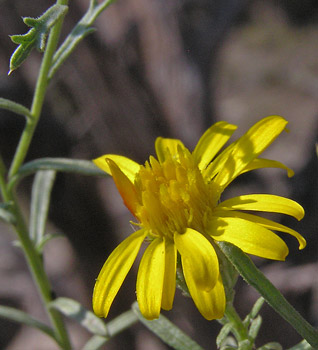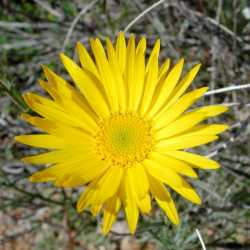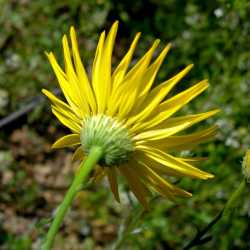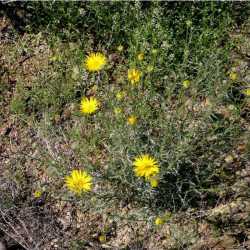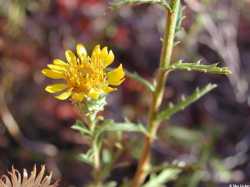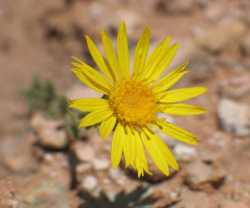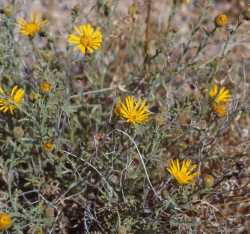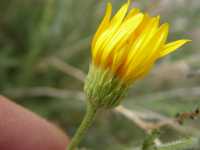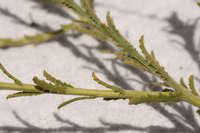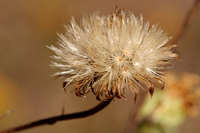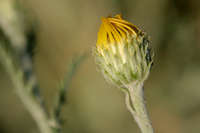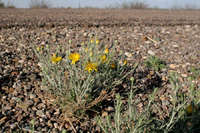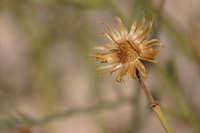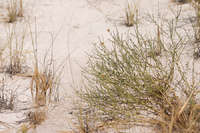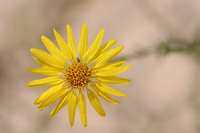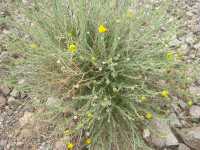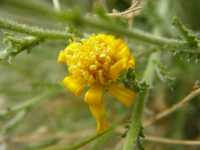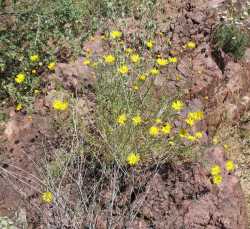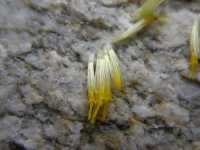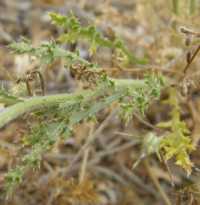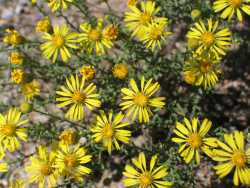Perennials or subshrubs, 10-100 cm; caudices branched, usually woody, taproots 2-18+ cm. Stems 1-30+, branched throughout or in distal 1 / 2 - 2 / 3 , moderately stout to stout, not wiry, hairy or glabrous, often stipitate-glandular. Leaves: basal sometimes withering by flowering, blades 1.5-3 × 0.8-1.3 cm, pinnatifid to 2+-pinnatifid; cauline variously spaced, blades oblong to lanceolate, 0.2-8 × 0.1-3 cm, not reduced markedly distally, margins deeply lobed to coarsely dentate or ± entire, teeth 4-18+ per side, each tipped with white bristles 0.2-1.8 mm, hairy or glabrous, often stipitate-glandular. Peduncles glabrous or hairy, often stipitate-glandular; bracts 0-3 leaflike. Involucres hemispheric to cupulate, 6-10 × 8-25 mm. Phyllaries in 5-6 series, linear to linear-lanceolate, 0.1-0.9 mm, apices acute to acuminate, tipped with white bristle, faces glabrous or hairy, often stipitate-glandular. Ray florets 14-60; corollas yellow, tubes 2.5-3.2 mm, laminae 5-12 × 1-2.5 mm. Disc florets 30-150+; corollas 4-5 mm. Cypselae narrowly obovoid, 1.8-2.5 mm, nerves 16-24, sparsely to moderately tawny hairy; pappi tawny, 4-6 mm, bristles progressively longer adaxially.
The following two binomials, referable here, are not valid because the name Sideranthus was invalid (nomen nudum) when the combinations were published: S. pinnatifidus Nuttall, and S. spinulosus (Pursh) Sweet. Furthermore, Eriocarpum australe Greene, probably also referable here, although validly published, has never been typified. The relevant synonyms are: Haplopappus spinulosus subsp. australis (Greene) H. M. Hall and Machaeranthera australis (Greene) Shinners.
Over many parts of its range, this species is represented by a series of morphologically distinct populations in isolated mountain ranges now connected by roads. The relatively mesic road right-of-ways form corridors for migration, thus leading to gene exchange. Likewise, long distance dispersal has helped to 'blend' many of these previously isolated and distinctive forms.
Xanthisma spinulosum 'is an exceedingly complex, variable taxon. It is doubtful that any `absolute´ key can be constructed so as to recognize unequivocally the infraspecific entities proposed here. Instead, we have composed a key that attempts to recognize character trends that serve, in combination, to distinguish a given taxon from another, but the occasional (if not frequent) specimen will be found that keys to a given regional variety but belongs to yet another. However, if one accepts the exception and recognizes our account as an attempt to portray variable, regional populations and not as a key to individuals, then little trouble should be experienced in pinning a varietal name on this or that collection' (B. L. Turner and R. L. Hartman 1976). The following key is adapted from the aforementioned source; the portion distinguishing var. glaberrimum follows G. L. Nesom (2003), in part.
B. L. Turner and R. L. Hartman (1976) distributed the varieties of this species under two subspecies. These are subsp. spinulosum, which includes vars. spinulosum, glaberrimum, and chihuahuanum, and subsp. gooddingii, which includes vars. gooddingii and paradoxum.
Duration: Perennial
Nativity: Native
Lifeform: Subshrub
General: Perennial herb or subshrub, 10-100 cm tall, from a woody, branched caudex; stems 1-30 or more per plant, branched throughout, hairy or glabrous, often stipitate-glandular.
Leaves: Basal leaves often withering by flowering, once or twice pinnately lobed, 1-3 cm long and 1 cm wide; stem leaves alternate, the blades 0.2 to 8 cm long, linear with entire margins, or oblong to lanceolate with deeply lobed or toothed margins, the teeth 4–18 or more per side, each tipped with a white bristle; leaf surfaces hairy or glabrous, often stipitate-glandular.
Flowers: Flower heads showy, yellow, and radiate, located at branch tips; involucres hemisperic to cupulate, 6-10 mm high and 8-25 mm wide, the bracts (phyllaries) in 5-6 graduated series, the outer phyllaries much shorter than the inner; phyllaries often stipitate-glandular, always straw-colored at the base, grading into a spot of dark green near the tip, and terminating in a white bristle; ray florets 14-60 per flower head, the laminae (ray petals) 5-12 mm long, yellow; disc florets 30-150 per flower head, yellow.
Fruits: Achenes 2 mm long, narrowly obovoid, about 20-nerved, and covered with tawny-hairs; topped with a pappus of tawny bristles, 4-6 mm long.
Ecology: Found on arid plains, mesas, and hillsides, from 1,000-5,500 ft (305-1676 m); flowers March-June.
Distribution: Most of western N. America from Manitoba south to TX, west to CA and south to s MEX.
Notes: Currently classified in Xanthisma, this species has formerly been placed in several other genera including Machaeranthera, Aster, and Happlopappus. Look for a perennial, sometimes woody at the base; flower heads with yellow rays and disks and phyllaries tipped with a white bristle; seeds with a tuft of bristles attached to the top; and leaves which are deeply lobed or toothed, each tooth tipped with a white bristle (though some leaves are linear and mostly lack teeth). Identify it as a member of the Machaeranthera/ Aster group by its flower heads with multiple rows of phyllaries, the outer much shorter than the inner, all with straw colored bases and dark green spots at the tip. However, it is easily distinguished from most members of the Machaeranthera/ Aster group by its yellow ray flowers (blue, purple and white are most common with other members of the group). Appears most similar to Xanthisma gracile, which also has yellow ray flowers, but that species is annual with a herbaceous base.
Ethnobotany: The Navajo used it to cure headaches.
Etymology: Xanthisma is a Greek name meaning that which is dyed yellow; pinnatifida means pinnately cut.
Synonyms: Machaeranthera pinnatifida, many others, see Tropicos
Editor: SBuckley 2010, FSCoburn 2014, AHazelton 2017
Several-stemmed perennial 2-6 dm, thinly tomentose at least when young, sometimes later subglabrate; lvs 1.5-6 cm נ2-10 mm, pinnatifid, with narrow lobes and narrow rachis less than 3 mm wide; achenes hairy, the nerves obscure; pappus persistent; 2n=16 + 2 B. Dry plains and foothills; Minn. to Alta. and Mex. July-Sept. Our plants are var. spinulosus. (Sideranthus s.)
Gleason, Henry A. & Cronquist, Arthur J. 1991. Manual of vascular plants of northeastern United States and adjacent Canada. lxxv + 910 pp.
©The New York Botanical Garden. All rights reserved. Used by permission.


